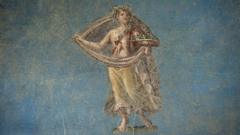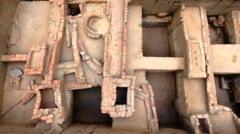The stunning ruins of Pompeii have once again captivated the world with a monumental discovery. Recently, archaeologists announced the unearthing of what may be the largest private bathhouse ever found in the ancient Roman city, buried under volcanic ash for 2,000 years. This remarkable site features luxurious hot, warm, and cold rooms, striking artwork, and an expansive plunge pool—a true testament to the opulence that defined the lives of its wealthy inhabitants.
Dr. Gabriel Zuchtriegel, director of the Archaeological Park of Pompeii, highlighted the significant implications of this discovery. "It’s almost as if the people had only left a minute ago," he said, emphasizing the preservation of these spaces which showcase the sophistication of Roman life. Analysis of two skeletons recovered from the bathhouse offers a chilling reminder of the peril that befell the city's residents during the fateful eruption of Mount Vesuvius in AD79.
The first skeleton, a woman aged between 35 and 50, was discovered clutching jewelry and coins, while a younger man's remains were found nearby. Both individuals attempted to seek refuge in a small room when a torrent of scorching gas and ash enveloped them. "Every discovery contributes to the narrative of this dramatic event," noted conservator Dr. Ludovica Alesse.
In addition to the bathhouse, additional structures unearthed by archaeologists include a bakery and laundry, suggesting they were all part of a grand estate possibly owned by Aulus Rustius Verus, a prominent figure in Pompeii. Dr. Zuchtriegel pointed out the rarity of having a private bath complex in Roman households, making this discovery a significant indicator of elite status.
The lavishness of the bathhouse invites contemplation; guests would have begun their experience in a vibrant changing room adorned with red walls and intricate mosaics before indulging in a series of detoxifying rituals, including hot baths and skin treatments, culminating in refreshing dips in the expansive plunge pool, which could accommodate dozens.
Furthermore, the grave contrasts between the opulence of the bathhouse and the grim realities for less privileged residents are poignantly evident. Behind the indulgent hot room lay a boiler room, reflecting the harsh labor conditions endured by slaves who maintained this luxurious experience for their masters.
Recent findings continue to emerge from the excavations, with tools and artifacts revealing a household caught in the midst of renovation when tragedy struck. Objects of daily life combined with luxury items speak to the humanity of its lost inhabitants. Notably, the treasures found alongside the victims suggest their desperate attempts to escape, clinging to belongings that held great personal value.
Dr. Sophie Hay, an archaeologist at the site, reiterated the significant social commentary these discoveries afford. The archaeological efforts represent a distinct juxtaposition between the lives of the wealthy and the realities of the enslaved, whose sacrifices often went unnoticed in the city's historical narrative.
As excavations near completion, and with limited opportunities for public viewing of the site, archaeologists remain optimistic about what additional finds may lie beneath the ash. Dr. Anna Onesti, the excavation's director, excitedly anticipated the revelations that await, stating, "Every day here is a surprise."
Pompeii continues to captivate modern audiences with stories of its past, from the grandeur of its social ceremonies to the harrowing narratives of its residents. Major findings like these not only enrich our understanding of ancient Roman life but remind us of the enduring legacy of human experience in the shadows of history.
Dr. Gabriel Zuchtriegel, director of the Archaeological Park of Pompeii, highlighted the significant implications of this discovery. "It’s almost as if the people had only left a minute ago," he said, emphasizing the preservation of these spaces which showcase the sophistication of Roman life. Analysis of two skeletons recovered from the bathhouse offers a chilling reminder of the peril that befell the city's residents during the fateful eruption of Mount Vesuvius in AD79.
The first skeleton, a woman aged between 35 and 50, was discovered clutching jewelry and coins, while a younger man's remains were found nearby. Both individuals attempted to seek refuge in a small room when a torrent of scorching gas and ash enveloped them. "Every discovery contributes to the narrative of this dramatic event," noted conservator Dr. Ludovica Alesse.
In addition to the bathhouse, additional structures unearthed by archaeologists include a bakery and laundry, suggesting they were all part of a grand estate possibly owned by Aulus Rustius Verus, a prominent figure in Pompeii. Dr. Zuchtriegel pointed out the rarity of having a private bath complex in Roman households, making this discovery a significant indicator of elite status.
The lavishness of the bathhouse invites contemplation; guests would have begun their experience in a vibrant changing room adorned with red walls and intricate mosaics before indulging in a series of detoxifying rituals, including hot baths and skin treatments, culminating in refreshing dips in the expansive plunge pool, which could accommodate dozens.
Furthermore, the grave contrasts between the opulence of the bathhouse and the grim realities for less privileged residents are poignantly evident. Behind the indulgent hot room lay a boiler room, reflecting the harsh labor conditions endured by slaves who maintained this luxurious experience for their masters.
Recent findings continue to emerge from the excavations, with tools and artifacts revealing a household caught in the midst of renovation when tragedy struck. Objects of daily life combined with luxury items speak to the humanity of its lost inhabitants. Notably, the treasures found alongside the victims suggest their desperate attempts to escape, clinging to belongings that held great personal value.
Dr. Sophie Hay, an archaeologist at the site, reiterated the significant social commentary these discoveries afford. The archaeological efforts represent a distinct juxtaposition between the lives of the wealthy and the realities of the enslaved, whose sacrifices often went unnoticed in the city's historical narrative.
As excavations near completion, and with limited opportunities for public viewing of the site, archaeologists remain optimistic about what additional finds may lie beneath the ash. Dr. Anna Onesti, the excavation's director, excitedly anticipated the revelations that await, stating, "Every day here is a surprise."
Pompeii continues to captivate modern audiences with stories of its past, from the grandeur of its social ceremonies to the harrowing narratives of its residents. Major findings like these not only enrich our understanding of ancient Roman life but remind us of the enduring legacy of human experience in the shadows of history.























